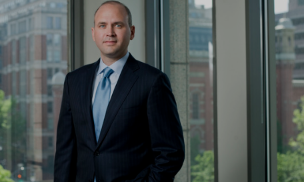 Heidi K Gardner is a Distinguished Scholar at Harvard Law School Center on the Legal Profession and is writing a book about the legal profession.
Heidi K Gardner is a Distinguished Scholar at Harvard Law School Center on the Legal Profession and is writing a book about the legal profession.
True rainmakers don’t need to be convinced to collaborate: referring work to colleagues and developing a loyal team capable of extraordinary client service is the only way they can build an enormous portfolio. But it’s no surprise: the bigger the account, the more stressful leading it becomes.
The more sophisticated the client, the more likely it is that the advisors with the specialist technical expertise needed to address their complex issues are distributed throughout the firm and possibly around the globe.
To appropriately tailor large-scale solutions, domain experts must work closely with colleagues in the local market who have deep contextual knowledge. The combination of large, distributed and global would be tricky enough, but we also have to acknowledge that those needed experts have their own client priorities which often don’t align with the rainmaker’s.
Based on our research at Harvard Law School’s Center on the Legal Profession, we focus on barriers and solutions for experienced rainmakers who are looking to take collaboration in their client account teams to the next level.
Future posts will address collaboration between lawyers and their clients – but we think that fixing issues of collaboration amongst partners is pretty foundational before you start extending it outside the firm.
In our prior posts in this series, we shared empirical evidence on the ways that collaboration can boost a lawyer’s rainmaking capabilities, resulting in higher business development revenues, a heightened personal reputation, and stronger client retention. Clearly the barriers to true collaboration can be quite daunting, and we offered a range of solutions to mitigate the obstacles – no silver bullets, but ways practical ways to make a difference.
Before we dive into more issues and solutions, let’s recognize that highly experienced rainmakers are likely get a number of additional benefits beyond the ones we discussed in prior posts.
Financial benefits of collaboration for experienced rainmakers:
The more experienced the rainmaker, the more likely they are to focus on client profitability – often because firms hold key client leaders to a higher standard.
The ultimate question, then, is whether multipractice service increases profits and not just revenue. The fear, of course, is that once you get deeply embedded in a client with huge teams from across your firm, the client will start using their buying power to demand discounted rates and other freebies. Why bother doing more work for less money? Our research suggests that this possibility is real, but that – on average – clients served with multipractice engagements are more profitable in the long run. Although I can’t share detailed findings for confidentiality reasons, I’m allowed to reveal this: data from some major international law firms shows that the profitability (in percentage terms) holds nearly steady as more practices are included in a client’s service mix. Naturally the numbers shift depending how narrowly you define practices, which “magnet practice” anchored the initial relationship, and so on, but the results on average show fairly steady margin rates even as the account size grew.
Given that these law firms are earning about the same percentage on much higher revenues, it’s clear that their overall profits stemming from cross-practice service are significant. Plus, if you take into account the significantly lower cost of sales for repeat versus new clients (does your firm capture this data?), then the balance tips further toward the cross-practice work.
I strongly encourage you to undertake similar analyses with your own data; if you find a different pattern, then it should trigger deeper inspection about the mix of practices, nature of your negotiations, and so forth. Overall, I expect you’ll find a pattern that illustrates what one Fortune 100 CFO recently told me about the link he has observed between his company’s outside advisors’ services and their profits: “Margins rise with complexity.”
But let’s be clear: These benefits only flow if clients are delighted by the value their legal teams provide. As Ben Heineman, GE’s former GC, has written, “Bigger isn’t necessarily better.” No GC is willing to pay for inefficient lawyers handing off work among themselves. They expect their legal teams to use adequate project management discipline to control quality and avoid billing for unnecessary work, poor work, and rework. Gurus like David Maister have been saying that for decades and we took the point for granted in prior posts. But at commentators’ urging, we’re now making it explicit.
Deeper benefits of collaboration for experienced rainmakers:
Experienced rainmakers have gotten past the nerve-wracking stage when they were unsure whether collaboration would ultimately pay out. Now that they’re reaping the return on their investment, they can focus on some of the emotional and other less tangible rewards that come from collaborating.
Clearly, money is important not only for purchasing power, but also as a status indicator. But most lawyers conform at least somewhat to models of normal adult development: the older and richer they get, the more likely they are to seek meaning.
And that’s where collaboration helps, too.
1. Intrinsic motivation of complex work: Lawyers tend to crave intellectual challenge. Collaborating across disciplinary boundaries allows them to move up the food chain in their clients, advising people whose challenges are increasingly complex and interesting. As one partner said, “If I’m doing work just in my specialty, then I’m almost certainly talking to clients with a narrow scope and more limited responsibility. Once I move into more sophisticated work, I move up toward the c-suite, and that’s when conversations get interesting.”
2. Power: When a CEO is in crisis and she calls on your team for advice, it’s a heady experience. Whether it’s advising the world’s business elite, directing hundreds of lawyers in a worldwide account team, or winning awards for legal innovation in a major client — all are sources of heightened power and prestige, and they are likely the result of a collaborative effort.
3. Issue spotting for opportunities or problems: Experienced rainmakers who build up a large client service team and who keep open the lines of communication reap huge advantages. First, more brains inside the client increase the odds of someone finding out crucial intelligence before your competitors do. On the flip side, it’s often the frontline lawyers who gain a real sense of how the client feels and whether they have concerns.
The most successful professionals are ones who cultivate an environment in their teams that encourages members not only to stay attuned to client issues and opportunities, but also to relay those messages directly to the partner in charge. One lawyer co-leads a client service team that stretches from Asia to Europe to the US spends enormous effort nurturing these relationships with his team. He said, “I want to focus on building trust with my partners so that I can give them feedback, they can give me feedback – I want to be first person to know, not last one, if I’m doing something stupid.”
4. Legacy: As the Chair of one major firm told me, “Some lawyers are more partner-like than others. Just as entrepreneurs want to leave a solid business behind for their children, these partners are motivated to pass on a strong client relationship to the next generation.” Research has found that building a legacy – that is, leveraging your achievements and values to help others succeed after you’re gone – is a prime source of enduring happiness. By helping to institutionalize the client relationship across multiple partners, experienced rainmakers build their legacy.
Read more at Bloomberg BNA






